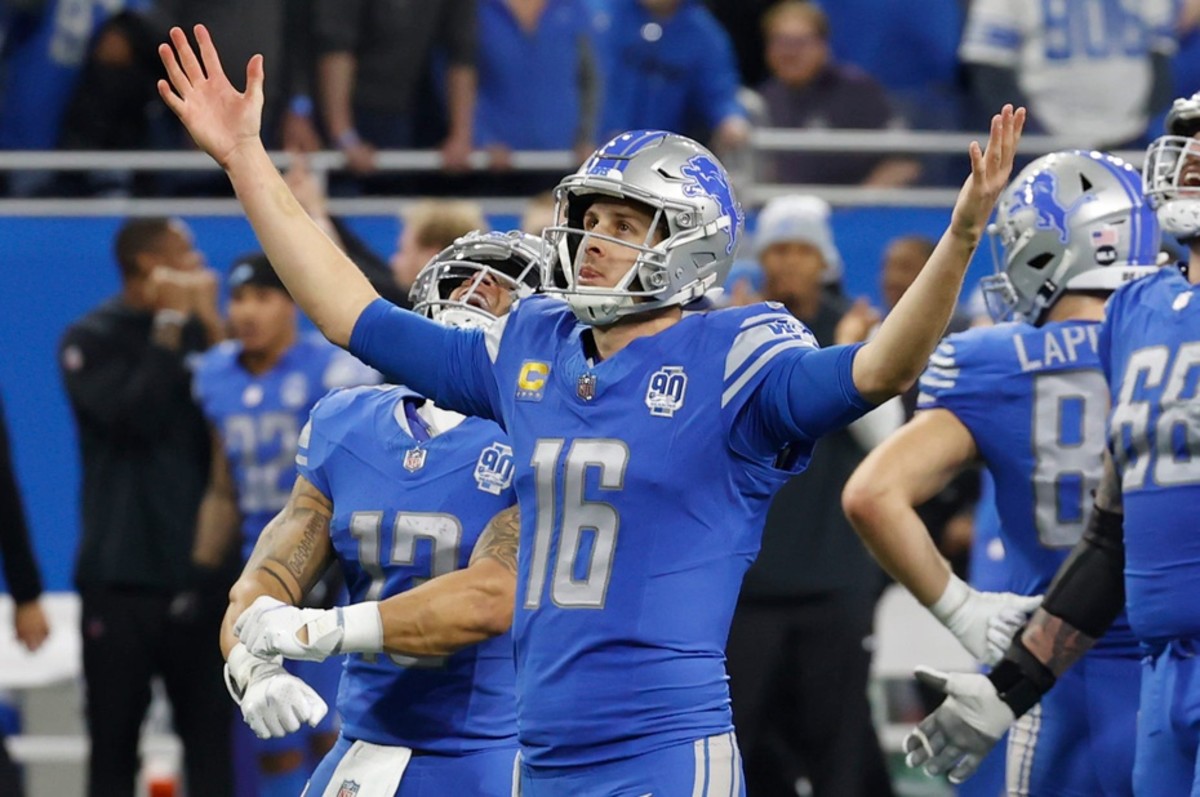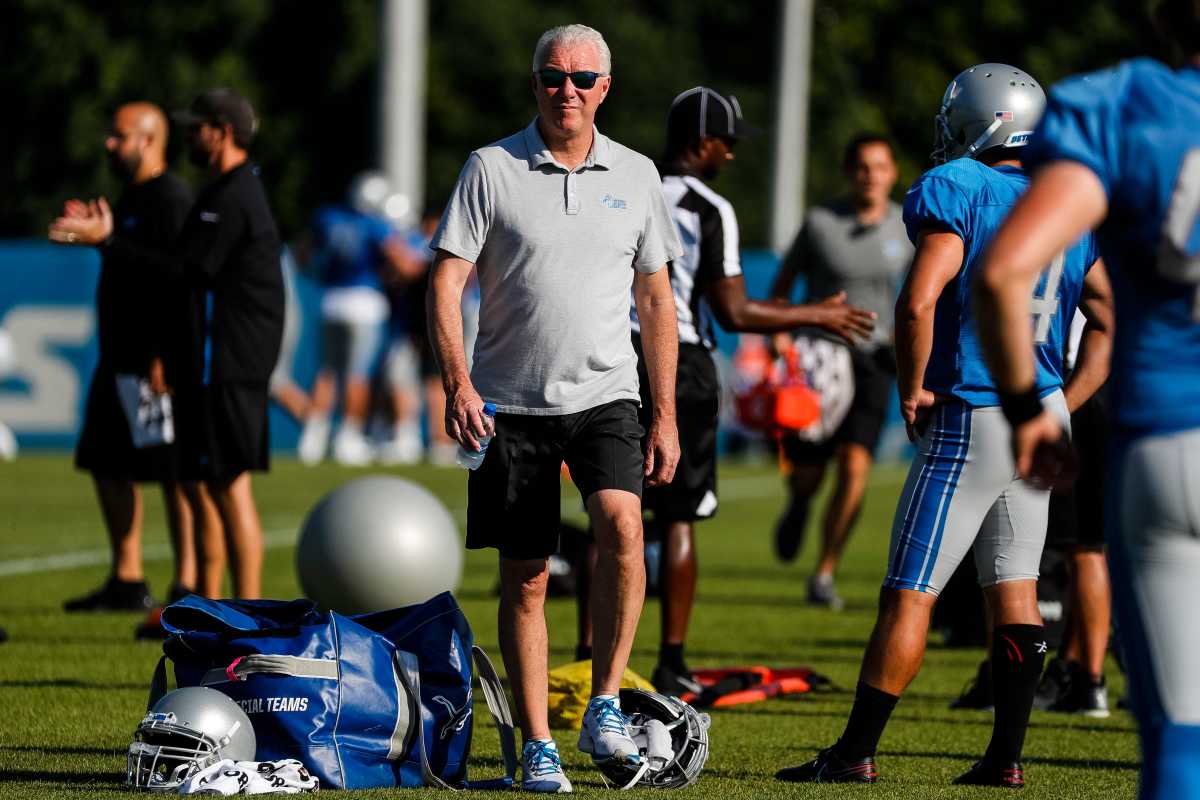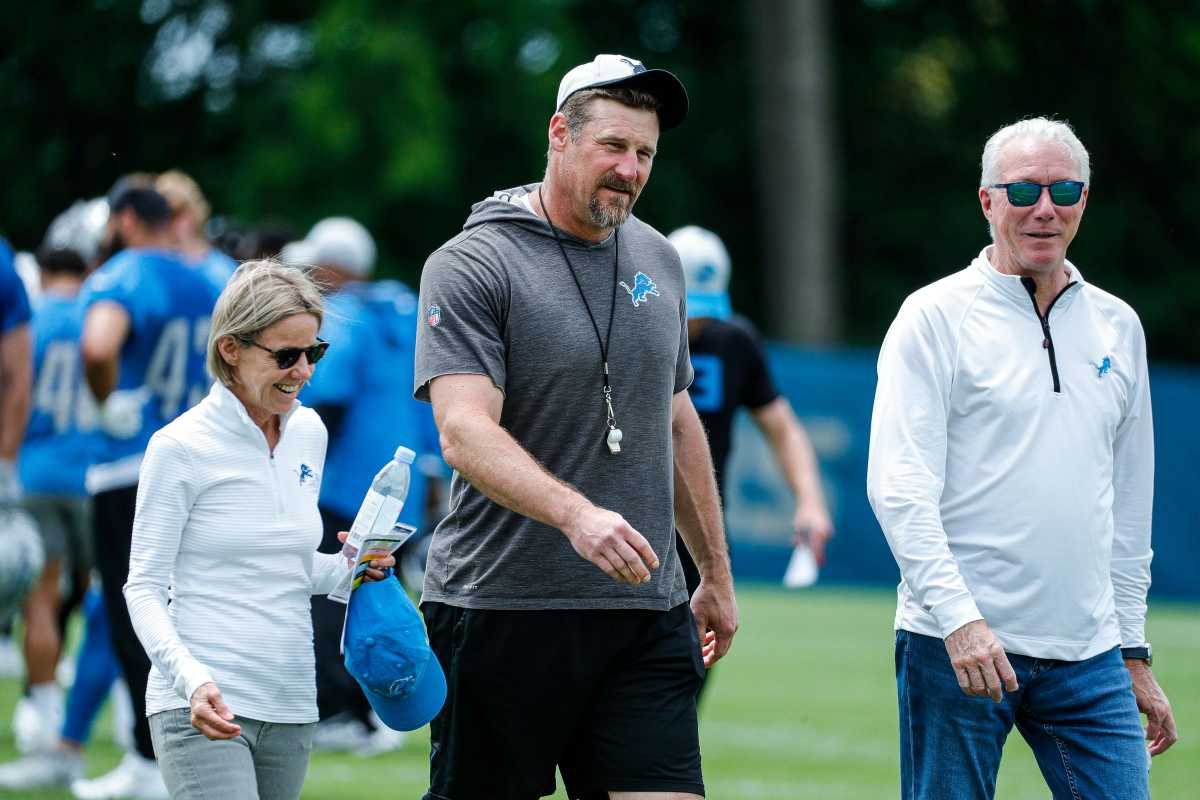A Lions Culture Led by Dan Campbell Paved the Way to First NFC Title Game in Decades

Three years ago, on a whiteboard in Lions president Rod Wood’s office, there were scribbled notes in black marker detailing what he (along with owner Sheila Ford Hamp, top exec Mike Disner and new hire/franchise icon Chris Spielman) was looking for in a general manager and coach.
Number one on the list was “leadership,” a word that stood alone, without any notes. Second was “culture,” with “Stay focused on this!” underlined four times next to it. And third was “staff,” with three arrows pointing off it, one to “manage,” another to “find the best,” and a third to “handling turnover.”
The list could’ve used an editor—culture was actually spelled cultur (I did get a look at it)—and the handwriting needed help. But the point of it, and vision for it, was crystal clear.
Wood, Hamp, Disner and Spielman all signed the board on Dec. 29, 2020, as they launched their search in earnest. Brad Holmes signed it about two weeks later on the day he landed the GM job. Dan Campbell did the same upon his hire on Jan. 20. And 36 months later, prints of that whiteboard, with pictures of Holmes and Campbell from the day they were introduced, hang in the office of all six of them.
They’re a reminder of a time, to those who were there, what the Lions were looking for then.

Want to know how Detroit got to its first NFC championship game since (the first) George H. W. Bush’s presidency? You can start with that whiteboard, and with the advice Wood now gives any team looking for a new head coach or general manager (a group that included a quarter of the league over the past couple of weeks).
“I would spend a lot of time defining what are we looking for and what are the personal characteristics that are important for us,” Wood says now. “I think in some organizations it might be that a play-caller’s really important. I wouldn’t argue that. It was kind of funny. Disner and I were talking about this a couple of days ago. The sweet spot lately seems to be an offensive-minded head coach who’s in their late 30s, whether that’s [Matt] LaFleur or [Sean] McVay or Kyle Shanahan, Zac Taylor, [Mike] McDaniel now.
“So if I were looking, I would certainly consider who’s the next 35- to 40-year-old good offensive mind. Our guy [offensive coordinator Ben Johnson] fits that definition with a couple of others. But that’s not necessarily what we were looking for. I also knew we were beginning a rebuild.”
The rebuild would be thorough, but it wouldn’t just be about adding new players. It would also be about bringing a totally new feel to the building.
Detroit—through three offseasons, a massive quarterback trade, a bevy of draft hits, and constant, relentless improvement—is now very clearly there. The identity of the team is as clear today as the list comprising the search committee’s vision three years ago.
The lessons others can take from that are bountiful, too.
Welcome to our annual breakdown of the conference-championship rosters. For the uninitiated, every January we dig into how the four teams that made it this far were built, looking under the hood for patterns or trends. And we have a couple here.
But first, the breakdown …
Baltimore Ravens
- Homegrown: 32 (25 draftees/7 college free agents)
- Outside free agents: 20
- Trades/waivers: 1
- Quarterback: Drafted Lamar Jackson 32nd in 2018
- Last five first-round picks: WR Zay Flowers (No. 22, ’23), S Kyle Hamilton (No. 14, ’22), C Tyler Linderbaum (No. 25, ’22), WR Rashod Bateman (No. 27, ’21), DE Odafe Oweh (No. 31, ’21)
- Top five cap figures: OT Ronnie Stanley $23.67 million, Jackson $22.15 million, TE Mark Andrews $13.66 million, CB Marlon Humphrey $12.46 million, LB Roquan Smith $9 million
Detroit Lions
- Homegrown: 28 (25 draftees/3 college free agents)
- Outside free agents: 19
- Trades/waivers: 6
- Quarterback: Acquired QB Jared Goff, a 2021 third-round pick, and first-round picks in ’22 and ’23 for QB Matthew Stafford
- Last five first-round picks: RB Jahmyr Gibbs (No. 12, ’23), LB Jack Campbell (No. 18, ’23), Aidan Hutchinson (No. 2, ’22), WR Jameson Williams (No. 12, ’22), OT Penei Sewell (No. 6, ’21)
- Top five cap figures: Goff $30.98 million, OT Taylor Decker $19.35 million, C Frank Ragnow $16.45 million, Hutchinson $8.12 million, Sewell $6.58 million
Kansas City Chiefs
- Homegrown: 31 (26 draftees/5 college free agents)
- Outside free agents: 19
- Trades/waivers: 3
- Quarterback: Drafted Patrick Mahomes 10th in 2017
- Last five first-round picks: DE Felix Anudike-Uzomah (No. 31, ’23), CB Trent McDuffie (No. 21, ’22), DE George Karlaftis (No. 30, ’22), RB Clyde Edwards-Helaire (No. 32, ’20), Mahomes (No. 10, ’17)
- Top five cap figures: Mahomes $37.13 million, DT Chris Jones $26.81 million, TE Travis Kelce $14.80 million, OG Joe Thuney $13.41 million, S Justin Reid $12.70 million
San Francisco 49ers
- Homegrown: 31 (28 draftees/3 college free agents)
- Outside free agents: 18
- Trades/waivers: 4
- Quarterback: Drafted Brock Purdy 262nd in 2022
- Last five first-round picks: QB Trey Lance (No. 3, ’21), DT Javon Kinlaw (No. 14, ’20), WR Brandon Aiyuk (No. 25, ’20), DE Nick Bosa (No. 2, ’19), OT Mike McGlinchey (No. 9, ’18)
- Top five cap figures: OT Trent Williams $12.58 million, DT Arik Armstead $12.11 million, Bosa $11.01 million, TE George Kittle $9.54 million, LB Fred Warner $9.05 million
O.K., so what you’ll find here, really, is three overarching things.
First, as roster construction has evolved with more aggressive young GMs, the sweet spot for homegrown players—to borrow Wood’s term—has settled in the low 30s. That allows for free-agent additions (such as Reid and Javon Hargrave) and trades (Smith and Goff), while also keeping an affordable talent base in place through deft drafting.

Second, aggressive cap management is now almost a prerequisite for getting this deep in the playoffs. The 49ers don’t have a player on their roster with a cap number over $13 million. Yet, there are eight players on the roster whose contracts average more than $15 million per year—which illustrates how they pushed money down the road to facilitate their roster in the here and now. Meanwhile, the Chiefs and Ravens have quarterbacks with cap numbers that are artificially low, knowing the time to pay will eventually come.
After that, you get to the crux of the Lions’ story, which is that every one of these teams has a strong identity. The Ravens have established theirs over a couple of decades. The 49ers and Chiefs have built their identities around superstar coaches, one younger and one older, that have constructed smart, crafty, tough rosters in their own image. Then, there’s Detroit, with a model that’s just as instructive as any of the other more well-worn ones in this round of the playoffs, if only because its basis can be applied anywhere.
For Hamp, Wood, Spielman and Disner, that identity started with looking at the Ford family’s larger business—and how the Lions of recent vintage had strayed from those ideals. With a hard look in the mirror, the group decided what they wanted amounted to a complete 180 from what they’d had.
Spielman went to work repairing the divide between the business side—centered downtown—and the football side—out in the suburbs. And that was the first step in the direction the group wanted its new coach and GM to take the Lions.
“Largely, Sheila and I having gone through what we went through before, it was realizing that wasn’t who we are,” Wood says. “That’s not who the Ford family is. We’re not a closed, secret, fearful organization. We wanted people who were going to be positive, open, transparent, inclusive, and really just embrace a culture where people want to work here.”

And to find that, they went to town on that whiteboard—with leadership, culture and staff emerging as the buzzwords they could fall back on as they dug through candidates.
The lists started with about 20 candidates for head coach, and 20 for GM. Since they’d landed previously on two people, Matt Patricia and Bob Quinn, who had come up together with the New England Patriots, the Lions resolved to run these searches on parallel tracks, but with an open mind toward matching two people who didn’t necessarily have the same background with one another.
Some candidates started on the list and wound up falling off—due to timing or because Detroit had heard they were lined up for another job—or because they turned the Lions down. Brian Schottenheimer, Brandon Staley and Pat Fitzgerald were among the names of interest who didn’t make it to the interview room. Others, such as Ed Dodds on the GM side, were added late. In the end, 12 GM candidates and eight coaches interviewed.
References played into it, too. Saints GM Mickey Loomis told Wood that “every coach will run to Detroit” to be on Campbell’s staff. Similarly, Rams COO Kevin Demoff told Wood that if he spent just an hour with Holmes, “it will not be a waste of your time. You will thank me.” Which made the two, for Wood, people of interest.
With Campbell, the feeling came instantly. The energy he (then a Saints assistant head coach) showed on a Monday morning Zoom, just hours after New Orleans had beaten Chicago in the wild-card round of the playoffs, jumped through the computer.
“He’s in some city, wherever they’ve been playing, it’s eight in the morning,” Wood says. “I don’t even know if he’d been asleep because he’d won the game at night and he’s preparing for the interview. He leans his face right up to the screen, takes a swig of his coffee and says, ‘I want this job.’ I said, ‘Shoot, we haven’t even asked you a question.’ … It wasn’t that he wanted to be a head coach in the NFL. He wanted to be the head coach of the Detroit Lions.
“He played here. He knew the passion of the city, the fans, what we’d been through, the ownership, this was the job he wanted. If he had been offered four jobs, he would have taken this job. That was important to me, too, was you wanted someone who wanted your job for all the right reasons.”
The Lions Already Knew They Were Winners
The moment with Holmes was, as you’d expect, a little more subtle.
The Lions liked how honest he was about the team; Holmes was the only candidate on the GM side who said he wouldn’t re-sign Kenny Golladay. And that genuine honesty really shone through when Holmes was asked to go through an exercise the committee presents to all its candidates.
“He had at that point worked for four or five different general managers,” Wood says. “I said, ‘What’s the one thing that you’ve learned that you would do and what’s the one thing you’ve learned from them that you wouldn’t do?’ He gave an incredibly detailed, thoughtful, honest answer about what he would do and what he wouldn’t do. It was third-level intellect. That’s when I said, This guy’s smart. He’s got the passion. He’s the guy.
“You can almost tell when somebody’s giving you an answer that, I knew that question was coming. Here’s the answer I rehearsed. Brad’s answer to that question was honest.”
Wood is big on first impressions, and he’d been taking note of those as he went through the process. With one candidate, he’d marked in the margin, “He’s Bob Quinn.” With another, he’d written there, “Old school.” With Holmes, it was simply, “This is the guy.”
Now, of course, not all of it was just on instinct.
The Lions loved that Holmes had a college scouting background—at that point, though no one else did, Detroit knew it was trading Stafford, and the committee wanted someone who could make good use of the draft capital it’d bring back. The Lions also liked that the Rams had given Holmes a good background in analytics, and that he had worked with a GM, Les Snead, that worked alongside Demoff, which was similar to how they expected their new GM to work with Disner over the long haul.
As for Campbell, with big checks in those all-important leadership, culture, and staff boxes, the clincher was that Campbell reminded Wood of the one coach who got away in 2018. That year, before hiring Patricia, then Texans DC Mike Vrabel crushed his interview. The Lions already knew which way they were going at the time, but Wood filed it away.
“It was in the back of my mind. I wouldn’t say I was looking for a Mike Vrabel clone, but I was looking for somebody that I had the same feeling about after I interviewed them,” Wood says. “You walked out and you said, I know nobody else is talking about this guy, but my gut tells me this guy’s going to make it. I had that same feeling about Dan.”
And all of Detroit is pretty happy that the Lions acted on that.
With the perspective of the past three years buoying him, Wood laughed as the words came out of his mouth, knowing where the conversation would go next: “The other thing that I would give anybody feedback on is don’t worry about what someone’s going to write the next day about your hire.”
Not many, after Campbell’s opening press conference, were writing positive things.
As Detroit’s new coach went through a monologue on biting off body parts over Zoom, Wood remarked to Hamp that it reminded him of a different, nonfootball hire he’d made for her family, in his previous job as an executive. Wood deadpanned, “Perhaps I should have had Dan go over the outline of his talk with me before he got up there.”

Of course by then Wood had conviction in the hires the Lions had made, and the chemistry they thought Campbell and Holmes could generate after putting them through a speed-dating-type meeting before getting their names on contracts.
Soon Wood’s resolve would be strengthened. With Holmes, it came early in that first training camp, when a rookie receiver who’d been catching everything came up with a grab over the middle, lowering his shoulder into a defensive back and setting off a small scuffle. Wood’s wife leaned over to him and said, “Who is this 14? I love him.”
It was Amon-Ra St. Brown, who would go on to catch 90 balls as a rookie. That Holmes was able to extract production like that out of the fourth round—and that St. Brown was able to compete like that before he played in a single game—got Wood excited.
Months later, when things were at their worst, similar signs came from Campbell, in his ability to make the most out of whatever he was given.
“We were 0–10, [and] it’d be really easy for the team to give up,” Wood says. “But we were playing hard. We got the first win, then we got the second win, then you got a third win. You could see that there was something different and special, that the team was playing so hard with really nothing to play for other than pride and him. It carried over.”
And it’s carried over since.
As for what was on that whiteboard? Those notes foreshadowed a similar vision for the team, in what Campbell and Holmes were looking to build. And it became a priority, if not a requirement, for players such as Penei Sewell, Aidan Hutchinson, Jahmyr Gibbs, Sam LaPorta and Brian Branch (and on and on and on) to embody those ideals before the Lions brought them in.
The result of it all, three years later, is the Lions are playing in San Francisco on Sunday for a trip to go to Super Bowl LVIII.
